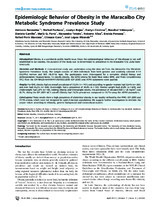Epidemiologic Behavior of Obesity in the Maracaibo City Metabolic Syndrome Prevalence Study

Ver/
Autor
López-Miranda, José
Bermúdez Pirela, Valmore José
Pacheco, Maikol
Rojas, Joselyn
Córdova, Evelyn
Velázquez, Rossibel
Carrillo, Daniela
Parra, María G.
Toledo, Alexandra
Añez, Roberto
Fonseca, Eneida
París Marcano, Rafael
Cano, Clímaco
López-Miranda, José
Editor
Public Libray of Science (PLOS)Fecha
2012Materia
ObesityBody Mass Index
Maracaibo (Venezuela)
epidemiological behaviour
METS:
Mostrar el registro METSPREMIS:
Mostrar el registro PREMISMetadatos
Mostrar el registro completo del ítemResumen
Introduction: Obesity is a worldwide public health issue. Since the epidemiological behaviour of this disease is not well
established in our country, the purpose of this study was to determinate its prevalence in the Maracaibo City, Zulia State-
Venezuela.
Materials and Methods: A cross-sectional study was undertaken using the data set from the Maracaibo City Metabolic
Syndrome Prevalence Study. The sample consists of 2108 individuals from both genders and randomly selected: 1119
(53.09%) women and 989 (46.91%) men. The participants were interrogated for a complete clinical history and
anthropometric measurements. To classify obesity, the WHO criteria for Body Mass Index (BMI), and Waist Circumference
(WC) from the IDF/NHLBI/AHA/WHF/IAS/IASO-2009 (IDF-2009) and ATPIII statements were applied.
Results: For BMI, obesity had an overall prevalence of 33.3% (n = 701), and according to gender women had 32.4% (n = 363)
and men had 34.2% (n = 338). Overweight had a prevalence of 34.8% (n = 733), Normal weight had 29.8% (n = 629), and
Underweight had 2.1% (n = 45). Adding Obesity and Overweight results, the prevalence of elevated BMI (.25 Kg/m2) was
68.1%. Using the IDF-2009 WC’s cut-off, Obesity had 74.2% prevalence, compared to 51.7% using the ATPIII parameters.
Conclusions: These results show a high prevalence of abdominal obesity in our locality defined by the WHO, IDF-2009 and
ATPIII criteria, which were not designed for Latin-American populations. We suggest further investigation to estimate the
proper values according to ethnicity, genetic background and sociocultural aspects.
